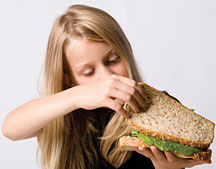3. Introduce Variety Early. Regarding infants, it's ideal to go from breast-feeding to organic baby food, and then consider making your own. Develop a strategy to introduce a wide variety of vegetables, remembering that the greener they are, the more vitamins and minerals they contain, and that vegetables with bright color bring antioxidants to your children's diet.
To prevent your child from developing a sugar addiction, avoid fruit juices, candy, ice cream and baked goods. The only sugar they should experience growing up should come from natural fruit. It's just too easy to get addicted to processed, overly sweetened foods; they'll have plenty of time for the occasional treat when they're older and have already developed a well-rounded, healthy diet.
4. Say No to Processed Foods. Avoid the trap many parents have fallen into, that of buying snacks marketed specifically by the manufacturers to start unhealthy habits. Children's cereals, colored crackers, cookies and the like are not healthy choices when you see the processing, dyes, and artificial flavors added to make these items "fun" to eat. Also keep in mind that two of the leading food allergies for children are wheat and corn (the latter more often in the form of a sweetener or additive in food products).
 5. Think Healthy Snacks. Prepackaged toddler foods seem to be the "in" foods these days, marketed as great for kids and easy for parents. Instead of buying into the marketing hype, pre-plan healthier options for your family. Finely chopped vegetables like red or yellow peppers, shelled snap peas, steamed broccoli heads or zucchini are better than prepackaged items; so are natural fruits - but not fruit rolls and juices, which are high-glycemic. Many whole- or natural food stores also have gluten-free crackers, cookies and breads (wheat often is a food-inducing allergy).
5. Think Healthy Snacks. Prepackaged toddler foods seem to be the "in" foods these days, marketed as great for kids and easy for parents. Instead of buying into the marketing hype, pre-plan healthier options for your family. Finely chopped vegetables like red or yellow peppers, shelled snap peas, steamed broccoli heads or zucchini are better than prepackaged items; so are natural fruits - but not fruit rolls and juices, which are high-glycemic. Many whole- or natural food stores also have gluten-free crackers, cookies and breads (wheat often is a food-inducing allergy).
6. Easy Meal Options. Who says you can't introduce vegetables with breakfast? Chop up, steam or lightly saute veggies and combine with a good source of protein (eggs or beans) and you're on your way to a complete, tasty meal. Wrap all this up in a whole wheat or sprouted tortilla and you have a healthy breakfast burrito. (The bean family is actually an overlooked source of protein for children.)
For lunches and dinners, it's important to find a balance with proteins, vegetables, salads and whole grains. If you're thinking, "How do I start?" realize there are resources and recipes that have been developed by parents who are in the same position as you are. A quick Internet search will get you started in the right direction.

